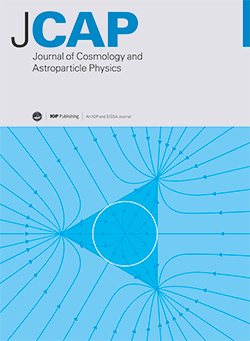Do JWST reionization (optical depth) puzzle, cosmological tensions, and CMB anomalies imply Harrison-Zel'dovich spectrum?
IF 5.3
2区 物理与天体物理
Q1 ASTRONOMY & ASTROPHYSICS
Journal of Cosmology and Astroparticle Physics
Pub Date : 2025-07-16
DOI:10.1088/1475-7516/2025/07/056
引用次数: 0
Abstract
The James Webb Space Telescope (JWST) has observed massive galaxies at high redshifts, which implies an earlier epoch of reionization (EoR) compared with the cosmic microwave background (CMB) results. In this paper, based on Planck 2020 (NPIPE release), ACT DR4 and SPT-3G data, if assumed a Harrison-Zel'dovich (HZ) primordial power spectrum in the standard cosmological model, we show that the redshift or optical depth of reionization is larger than the case of a power-law (PL) primordial power spectrum. In HZ-ΛCDM model, the redshift of reionization is zreio = 9.11 ± 0.61, which is consistent with the JWST result that zreio ≈ 8.9. Moreover, the cosmological tensions, i.e. Hubble (H0) tension and S8 tension are alleviated in HZ-ΛCDM case. The Hubble constant is H0 = 70.38 ± 0.35 km/s/Mpc and the structure growth parameter is S8 = 0.7645 ± 0.0094 in HZ-ΛCDM model. We also consider two extensions of ΛCDM, including ΛCDM+AL and ΛCDM+Ωk models. But the extensions of ΛCDM with a HZ spectrum meet more serious CMB anomalies, i.e. lensing anomaly and spatial curvature anomaly as compared with the extensions of ΛCDM with a PL spectrum. We discuss that these two CMB anomalies may come from the degeneracy of cosmological parameters.JWST再电离(光学深度)难题、宇宙张力和CMB异常是否意味着哈里森-泽尔多维奇光谱?
詹姆斯·韦伯太空望远镜(JWST)已经观测到大质量星系的高红移,这意味着与宇宙微波背景(CMB)结果相比,再电离(EoR)时代更早。本文基于Planck 2020 (NPIPE release)、ACT DR4和SPT-3G数据,在标准宇宙学模型中假设Harrison-Zel'dovich (HZ)原始功率谱,表明再电离的红移或光学深度大于幂律(PL)原始功率谱。在HZ-ΛCDM模型中,再电离的红移为zreio = 9.11±0.61,这与JWST的结果zreio≈8.9一致。此外,在HZ-ΛCDM情况下,宇宙学张力即哈勃(H0)张力和S8张力有所减轻。在HZ-ΛCDM模型中,哈勃常数为H0 = 70.38±0.35 km/s/Mpc,结构生长参数为S8 = 0.7645±0.0094。我们还考虑了ΛCDM的两个扩展,包括ΛCDM+AL和ΛCDM+Ωk模型。但是,与具有PL谱线的ΛCDM扩展相比,具有HZ谱线的ΛCDM扩展会遇到更严重的CMB异常,即透镜异常和空间曲率异常。我们讨论了这两个CMB异常可能来自于宇宙学参数的简并。
本文章由计算机程序翻译,如有差异,请以英文原文为准。
求助全文
约1分钟内获得全文
求助全文
来源期刊

Journal of Cosmology and Astroparticle Physics
地学天文-天文与天体物理
CiteScore
10.20
自引率
23.40%
发文量
632
审稿时长
1 months
期刊介绍:
Journal of Cosmology and Astroparticle Physics (JCAP) encompasses theoretical, observational and experimental areas as well as computation and simulation. The journal covers the latest developments in the theory of all fundamental interactions and their cosmological implications (e.g. M-theory and cosmology, brane cosmology). JCAP''s coverage also includes topics such as formation, dynamics and clustering of galaxies, pre-galactic star formation, x-ray astronomy, radio astronomy, gravitational lensing, active galactic nuclei, intergalactic and interstellar matter.
 求助内容:
求助内容: 应助结果提醒方式:
应助结果提醒方式:


